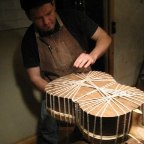Welcome to one of the most active flamenco sites on the Internet. Guests can read most posts but if you want to participate click here to register.
This site is dedicated to the memory of Paco de Lucía, Ron Mitchell, Guy Williams, Linda Elvira, Philip John Lee, Craig Eros, Ben Woods, David Serva and Tom Blackshear who went ahead of us.
We receive 12,200 visitors a month from 200 countries and 1.7 million page impressions a year. To advertise on this site please contact us.
|

|
|
I am new
|
You are logged in as Guest
|
|
Users viewing this topic: none
|
|
Login  | |
|

   
Peter Tsiorba
Posts: 130
Joined: Oct. 27 2009
From: Portland, Oregon Pacific Northwest

|
 RE: I am new (in reply to Ronald) RE: I am new (in reply to Ronald)
|
|
|
You can use common textile dye, such as Rit, usually sold in grocery stores and intended for dyeing or "touching-up" color in your clothes. These dyes are pretty cheap, not terribly toxic, and although water-based (yes, you can cook veneer in this dye) are reasonably water resistant after you use some mordant. Mordants can be many things, some of the common being vinegar, salt, baking soda, etc.. Again the common stuff found in grocery stores. Rit dye will have specific instructions as to the type of mordant they call for.
American Lutherie magazine http://www.luth.org/backissues/al69-72/al71.htm profiles rosette work by Eugene Clark--check out issues 71 and 73. Excellent articles, and very detailed, yet accessible treatment of the subject, including dyeing of the veneers. I highly recommend for you to get those two back issues if you are serious about getting into your own rosette and line work. If you need some already dyed veneers in sheets, it will be difficult to track down. Most veneer sold is too thin, and has some sort of paper backing, pretty useless stuff for our purposes. One source I've been using is B&B Rare Woods, and they have some excellent European-made dyed veneers in sheets. Veneers are thick enough. Here is some of the dyed veneer stuff they have:
http://www.wood-veneers.com/veneer_dyed.html
I hope this is helpful, and I wish you a very enjoyable experience in building your first guitars!
_____________________________
Peter Tsiorba
Classical-Flamenco-Guitars
tsiorba.com
|
|
|
|
REPORT THIS POST AS INAPPROPRIATE |
Date Dec. 27 2009 14:51:32
 |
|
 New Messages New Messages |
 No New Messages No New Messages |
 Hot Topic w/ New Messages Hot Topic w/ New Messages |
 Hot Topic w/o New Messages Hot Topic w/o New Messages |
 Locked w/ New Messages Locked w/ New Messages |
 Locked w/o New Messages Locked w/o New Messages |
|
 Post New Thread
Post New Thread
 Reply to Message
Reply to Message
 Post New Poll
Post New Poll
 Submit Vote
Submit Vote
 Delete My Own Post
Delete My Own Post
 Delete My Own Thread
Delete My Own Thread
 Rate Posts
Rate Posts
|
|
|
Forum Software powered by ASP Playground Advanced Edition 2.0.5
Copyright © 2000 - 2003 ASPPlayground.NET |
0.0625 secs.
|


 Printable Version
Printable Version







 New Messages
New Messages No New Messages
No New Messages Hot Topic w/ New Messages
Hot Topic w/ New Messages Hot Topic w/o New Messages
Hot Topic w/o New Messages Locked w/ New Messages
Locked w/ New Messages Locked w/o New Messages
Locked w/o New Messages Post New Thread
Post New Thread